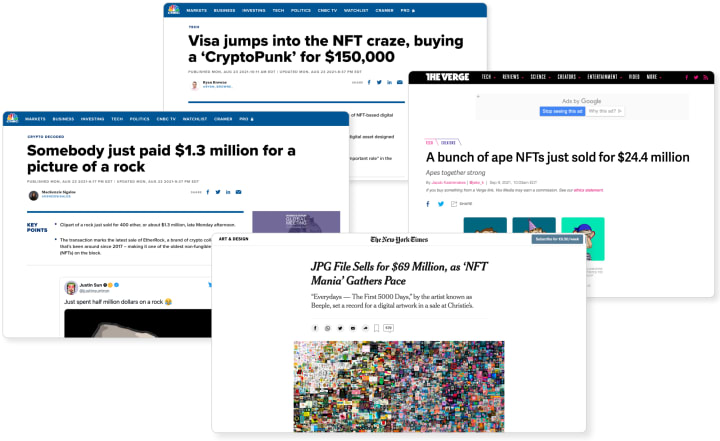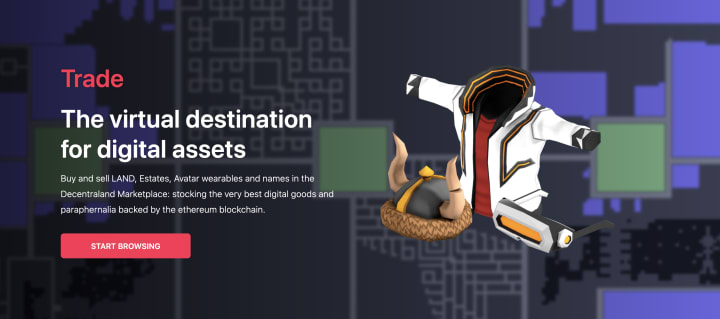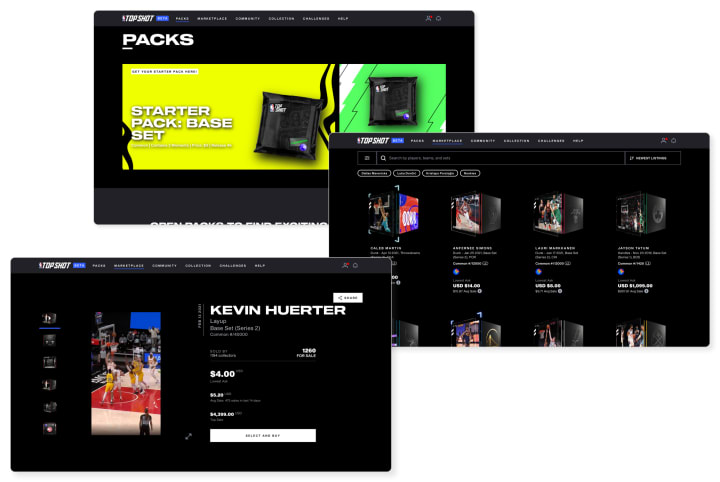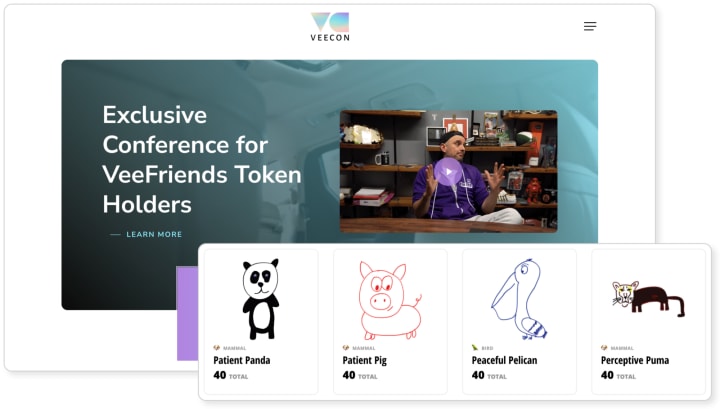4 Common Misconceptions About NFTs
NFTs are neither a scam nor are they synonymous with art and weird collectibles for the ultra-rich

Mainstream media and public discourse naturally focus on the most news-worthy and sensationalist sales, projects, and trends in the NFT space and generally don't do a good job of explaining the fundamental value of NFTs, how they work, and what they actually are.
All of this leads to a range of misconceptions about the technology which I'll debunk one by one so you'll at least have the facts and a proper foundation for deciding whether or not NFTs are worth your time and money.
Although I wrote this piece as an overview and saved the in-depth analysis and additional examples for some upcoming articles, it still ended up as a rather lengthy one. Turns out there's a lot to say about NFTs and I like talking about them. Who would have guessed??
In any case, if you just want the skinny right away, here's the TL;DR.
Misconception #1: Because NFTs are nothing more than image files, they can easily be copied by anyone on the Internet, making the original worthless.
The truth: While you can easily copy the image of a digital collectible or piece of art, NFTs prevent its true value - its provenance - from being copied.
Misconception #2: NFT art and avatars have zero utility and can't even be displayed and enjoyed anywhere because they're digital.
The truth: People are displaying their NFT art and collectibles in multiple ways, and many of them even provide a lot more value than their aesthetics.
Misconception #3: All NFTs are art, avatars, and weird collectibles.
The truth: NFTs are simply a technology that enables ownership of digital assets and has countless use cases beyond what gets the attention right now. Think gaming, music, tickets, access keys, and much more.
Misconception #4: But hey, screw all the above, NFTs are crazy expensive anyway, completely out of reach for us normal people.
The truth: You can find lots of NFTs priced at a few dollars or even completely free, or buy fractions of blue-chip NFTs to get exposure as an investor.
Now, let's take a step back and explore what's behind these misconceptions. I will be using multiple examples of NFTs, some of which I own, wish to own, or might sell in the near future. None of this is financial advice. I'm flattered if you use this article as part of your NFT research, but please do more than that before deciding to put money into this space.
Where do these misconceptions come from?
Many people still see NFTs as a useless fad fueled purely by speculation among the rich. They still believe NFTs will completely die out and not be around in a few years. At the very least, they have completely dismissed NFTs as being utterly useless to them.
There's no doubt in my mind that financial speculation plays a huge role in the current NFT bull market. Many of the new NFTs and NFT projects will likely be worthless and forgotten in a few years.
At the same time, I'm just as convinced that NFTs are here to stay. Not only that, they will become a much, much larger part of our daily lives than they currently are, in so many more ways than we can even imagine.

When people can look at the same technology and have completely opposing views on its potential, it's typically because of misconceptions about how the technology actually works. This also seems to be the case for NFTs.
But what's behind these misconceptions? I won't attempt to map out the proper timeline of historical events, at least not in this article, but rather just outline the different ingredients that seem to have played a role in how NFTs are perceived - and misconceived - by the general public.
1. Revolutionary technology
It's by no means obvious why NFTs can't just be copied like any other digital file, essentially making the "original" worthless. At first glance, it simply doesn't make sense because it fundamentally changes so many things we just take for granted about digital assets and how we use them.
2. Poor branding
As if the technology wasn't complex enough in and of itself, the fact that we're even calling them "NFTs" is terrible branding. NFTs are simply a technology that can be used for countless different purposes. It just so happens that digital art and collectibles are two of the first use cases to gain traction.
The techy branding works well for the first main target audience though. I and my fellow NFT collectors and creators get what we're talking about. Furthermore, we had some Internet money to spend.
3. Lots of new money jumps in
Combine fun and exclusive crypto-native collectibles with a large group of newly-rich crypto people who have plenty of ETH to spend, and you got the perfect setup for NFT prices to surge.
Despite there being lots of low-priced NFTs available, as I'll get into later, NFT Twitter is still largely a bunch of thousand-dollar profile pictures bragging about their latest $10k flip. It's just more exciting to talk about that stuff!
4. Money attracts attention (and more money)
The surge in NFTs attracted more artists, illustrators, and creators of various kinds to the space, seeing a way to make money off of their work. At the same time, more money came into the space from famous athletes, musicians, actors, and entrepreneurs, as well as more traditional investors and investment managers. The snowball effect had kicked in.
5. Mainstream media picks up on the craze
Just like we like to talk about and show off our most expensive NFT purchases on Twitter, mainstream media clearly gravitates toward the most outlandish stories from the NFT world.
The most newsworthy sales are always the ones with the highest prices relative to their apparent value. Great art sold at a high price is interesting, sure. A $1.3 million picture of a digital rock, now that's a headline!

So, we've got a strange new technology with a shitty branding department, a ton of money flowing into it, and media outlets competing on sensationalist headlines… It's no wonder the NFT hype seems like obvious speculation in a complete bullshit bubble that'll burst as soon as everyone comes to their senses and admits NFTs are a fad.
Now, since I'm clearly of a different opinion, let's tackle each misconception one by one and shed some light on what these NFTs really are.
Debunking misconception #1: Why your NFT screenshot is worthless
I already covered this issue in greater detail in a previous article, so I'll keep it brief here. The thing is, your image of a CryptoPunk or one of XCOPY's works isn't actually the valuable part of what you own. In simplified terms, the image comes with an NFT attached to it, which serves as the provenance and proof of ownership of what you just bought. And that is what people are buying for thousands and millions of dollars - it's not the image itself.
Because there's an actual token and not just an image, your screenshot is worthless from two different perspectives: From an investment perspective and from a utility perspective.
No one will buy the digital piece of art you right-click-saved. If you don't have the actual token, the NFT associated with the visual representation, you'll need to be a skilled scammer to pull off a sale like this.

With that being said, you clearly can use the image of an NFT as your wallpaper or a print on the wall if you like how it looks. It's no different from the real world where the art market is thriving despite cheap Picasso posters being readily available. You might infringe on some copyrights and your NFT friends will definitely shame you to oblivion for it, just like your artsy friends would ridicule you for that Picasso poster, but hey, you do you.
This talk about your screenshot being worthless naturally leads us to our next misconception: The one about NFT art and avatars having no utility, not even as decorations.
Debunking misconception #2: Your NFT avatar is more valuable than you think
Let's say you find an NFT you actually like the look of and want to buy, at least now that the screenshot concern is out of the way. How would you even display it?
How collectors are displaying their NFTs
There's a very popular trend going on in the NFT world where people use their Bored Ape, Cool Cat, CryptoPunk, or any other less known (and much more affordable) NFT avatar as their online avatar. It may not seem like enough to justify the prices of some of these NFT avatars, but it's an important cultural trend and something that's used as a status symbol. I wrote a short piece on this if you're interested in learning more about the trend.

Furthermore, art and avatars alike are being displayed and shown off in a myriad of ways. Collectors use their artworks as wallpapers on their phones, smartwatches, tablets, and laptops. Some have them printed and hung on the wall at home. Digital frames and new ones like Nifted, designed specifically for displaying NFTs, provide a digital-native solution.
Mynt, CryptoVoxels, Cyber, and others let you display your own and enjoy others' NFTs in a 3D gallery format. Some galleries showcase the community's pieces, like Mirage Gallery shown below. The proliferation of VR technology and metaverse platforms like Decentraland and The Sandbox will further improve this solution.

All that being said, the primary value of most NFTs isn't aesthetic, although you may like how it looks and enjoy having it on display.
Your avatar isn't just an avatar
It's common to hear people talk about "collecting jpegs", but actual NFT collectors say it (somewhat) ironically. Owning one of these NFTs - the token that is, not just the image - will often provide you with a lot more than just a pretty avatar. When you buy an NFT, your money is used by the creators to fund their future development. Here are a few examples:
- Rewards. Most NFT projects do some sort of raffles or competitions among their community members, enabling you to win additional NFTs, cash prizes, or other perks.
- Early or exclusive access to new NFTs. Many collections expand with new characters or make collaborations with other creators and give you early access or a discount on the purchase of these new NFTs.
- Free airdrops of new NFTs. The new characters or collab pieces may even come for free, just like new items and accessories for your NFT may be airdropped to you as an owner. They're all created and traded as NFTs and worth real money if you wish to cash out.

- Secondary market revenue share. Most NFT projects get a royalty of all secondary market sales, typically around 5%, and some choose to distribute a portion of this to their NFT owners.
- Co-ownership of a media and entertainment business. Some projects, like Gambling Apes and their metaverse casino, take it a step further and make their NFT holders co-owners of their business ventures.
- Access to exclusive merchandise. Another very common trend is for NFT collections to create their own branded clothing and give owners of their NFTs exclusive access or a discount on their purchases.

- Access to closed chats and forums. Many NFT projects have Discord channels that you'll only get access to after verifying that your ownership of one of their NFTs. Some of them provide serious talks about promising new NFT projects and general knowledge sharing.
- Exclusive access to events. Some NFT projects are doing both online and offline community events and meetups.
- Stake to earn. CyberKongz and Anonymice are two of the most well-known examples, but lots of NFT projects either have or are creating their own utility tokens, which owners can earn by "staking" their NFTs and then use for purchases, gaming, or other things within the ecosystem.
- Metaverse character. NFTs will play an important role in the metaverse and many avatar projects have already created 3D versions for virtual spaces like The Sandbox, Decentraland, and Somnium Space, and whatever Meta (formerly Facebook) is currently working on.

- Gaming character or item. Some projects are working on games in which you'll be able to play as your NFT avatar and sometimes earn new NFTs, tokens, or cash through the popular 'play-to-earn' model. Rumble Kong League and their 3 vs 3 basketball game is one example of this.
- Donations to charity. Many NFT projects commit a certain percentage of their revenue to charity before they launch, and some projects are even created specifically to support and raise awareness for a certain cause.
Artworks sold as 1-of-1s or editions are a little different but often give you some additional benefits as well, other than looking awesome when you display it in one of the many ways mentioned above.
Now, if you aren't yet ready to jump into a $4,000 digital drawing of a cat, let's instead jump to misconception number 3 and talk about the vast world of NFTs beyond art and avatars.
Debunking misconception #3: NFTs are a lot more than art and avatars
I won't bore you to death with a technical deep-dive into non-fungible tokens and I already touched on it above: NFTs are just a technology, basically a digital certificate of ownership that can be attached to any digital asset.
NFTs are not synonymous with digital art and avatars, and there's even a lot more to these than meets the eye, as we outlined above.
While art and avatars may be two of the first use cases of the NFT technology to gain some momentum and mainstream attention, there are plenty of other examples already out there:
- Axie Infinity is the most popular play-to-earn game where players own their NFT game characters and earn money through staking, breeding, battling, and more.
- NBA Top Shot, one of the most popular platforms utilizing NFTs, lets you collect and trade video moments from the NBA as NFTs.
- Sorare is a platform for digital soccer cards created as NFTs so you can collect, trade, and use them in fantasy gaming.
- You can buy plots of land and real estate as NFTs in virtual worlds like Cryptovoxels, The Sandbox, and SuperWorld.
- NFTs like Tom Bilyeu's Impact Theory Founders Key and some of Gary Vee's VeeFriends serve as access keys to the founders and various benefits provided by them.
- Zombie Cats, The Diamond Hands, HeadDAO, and others give you fractional ownership of a portfolio of valuable NFTs like Cool Cats, CryptoPunks, and the Bored Ape Yacht Club. More on that later.
- The main value proposition of the VeeFriends NFTs mentioned above is arguably the fact that they serve as tickets - the only tickets available - to Gary Vee's upcoming annual conference, VeeCon, for the next 3 years.
- Unstoppable Domains sell domain names as NFTs, allowing you to actually own your domain rather than just rent it.
- Digital tools like Cyber Babies, an NFT trading tool, sell their licenses in limited quantities as NFTs. This enables you to resell your membership at a later point in time if you stop using the tool, and potentially make a profit because of the fixed supply if demand for the tool has gone up.

These are just a few examples of what the NFT technology is already being used for and what "buying an NFT" can actually mean. We're just scratching the surface of the technology's potential though. I believe NFTs will become an integral part of our lives in many more ways than we can even imagine.
Debunking misconception #4: NFTs aren't just for millionaires
Now, there's no denying that the most popular NFT collections and artworks have reached a price level that's unattainable for most people. NFTs are now selling for millions of dollars on the secondary market and at Sotheby's and Christie's auctions.
Despite spending so much time explaining the utility and underlying value of NFT avatars, I won't try to argue that the "utility" of the most valuable NFTs justify their price tags. Some of them are undoubtedly priced in the same way as contemporary art, collectibles, and memorabilia of the physical kind.
Items like these are selling for millions of dollars because of branding, IP, signaling, value as status symbols, sentimental value, and their historical and cultural significance. In other words, you can't quantify their value or justify it from a utilitarian perspective. Thus, you can easily argue that contemporary art and trading cards aren't worth what people are paying for them, and you can just as easily make the case for Fidenzas, CryptoPunks, and Bored Apes.
That being said, art and collectibles have been collected and traded in the real world for ages based on these psychological drivers and continue to be great investments if you can pick the right ones.
Furthermore, the demand for their digital counterparts is clearly there as our lives move more and more into the digital world. This is certainly a valid investment thesis and one that many people in the NFT market seem to be pursuing. However, even if this isn't your style, we've now got plenty of other types of NFTs with more justifiable price tags.
The price for utility
There's a vast market of NFTs selling for hundreds or a few thousand dollars. Now, if you look at these through the lens of all the misconceptions outlined above, you could certainly argue that these were still "expensive". But I hope your perspective has changed by now.
As we just covered, NFTs can serve as memberships, access keys, game characters, co-ownership of NFT portfolios, or even investments in media companies and IP. From this perspective, paying $1,000 or even $10,000 for an NFT might no longer seem so crazy.

Put differently, "expensive" is a relative term. Digging into the business cases and cultural movements fueling some of the largest NFT projects at the moment, I still see many of them as outright cheap.
Now, if you get why some NFTs cost a lot of money but you're still not ready or can't afford to spend hundreds or thousands of dollars on one, I have even more good news for you.
Low-priced NFTs
There are hundreds of serious NFT projects on the market with very low price points and multiple new ones launching every day. Most new projects of the popular generative avatar type launch with a price per NFT of $100 to $400 and you'll also find plenty in this price range on the secondary market. The best ones usually go up in value as soon as they launch, so it pays to stay on top of upcoming launches on sites like NextDrop, Rarity.tools, and alphadrop.
While $100 is certainly far below the price tags you hear about on the news, it isn't exactly free either. Luckily for us, there's actually a whole world of NFTs of various kinds selling for a few dollars.
Most of the expensive avatar collections are built on Ethereum where gas fees automatically prevent the true bargains. There's no point in selling or buying a $10 NFT when the transaction fee will be at least $30.

Other blockchains with low to no fees, like Solana, Tezos, WAX, and others, make low-priced NFTs much more viable. I'd recommend checking out the selection of art, collectibles, game items, and other types of NFTs on Magic Eden, Atomic Hub, Objkt.com, and other marketplaces. You can learn more about these in my guide to the most popular NFT ecosystems.
You can buy a fraction of a million-dollar NFT
Lastly, I'll just mention a new concept that I think has huge potential and serves a similar function as the DAO type NFTs mentioned earlier: Fractionalization of NFTs.
Platforms like Fractional.art are doing for NFTs what Masterworks is doing for art. They're enabling you to buy a small fraction of a CryptoPunk, for instance, so you don't need to put up $500k to get exposure to it as an investor.

It's still super early days for NFTs, let alone the fractionalization of them, but if you're priced out of the most expensive ones but still think they're a good investment, you may want to keep a close eye on the space.
Key takeaways
While NFTs have taken off in a huge way in 2021, it's really only two or three use cases that are getting all the attention. Furthermore, the public discourse about NFTs leads to a set of misconceptions that cause many people to dismiss them as useless, irrelevant for them, or an outright fad.
If you're one of the skeptics, I hope this article cleared up at least some of the misconceptions and perhaps made you a little more interested in exploring the exciting new world of NFTs. I can tell you from experience that it's easy to get sucked in and completely immerse yourself in everything that's going on as soon as you start learning and buy your first NFT. You don't need to get as obsessed as I am, but I hope you'll at least take the time to understand what's going on before you decide to ignore NFTs for one of the wrong reasons.
About the Creator
Christian Jensen
I’m a designer, investor, and crypto nerd, writing about the intersection of creativity, culture, technology, and finance.
#NotFinancialAdvice






Comments
There are no comments for this story
Be the first to respond and start the conversation.